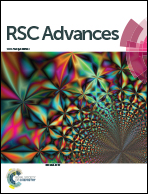Analysis of the water extract of waste papaya bark ash and its implications as an in situ base in the ligand-free recyclable Suzuki–Miyaura coupling reaction†
Abstract
The conversion of waste papaya-bark to ash–water extract via low-temperature combustion, and its utilisation as an efficient and environmentally friendly in situ basic medium for the Suzuki–Miyaura cross-coupling reaction at room temperature are reported. The papaya-bark ash was characterized by EDX, ion-exchange chromatography and flame photometry to reveal a broad range of active metal oxides. The chemical analysis reports of ash showed the presence of oxides of K, Ca, Na, Li and Mg, which possibly in the presence of water produce the corresponding hydroxides in situ, responsible for the basicity. Application of the ash–water extract as a base was highly effective for ligand-free Pd(OAc)2 catalyzed Suzuki–Miyaura cross-coupling reaction. The reaction proceeds smoothly without any promoter/ligand to give excellent yields. Moreover, after completion of the reaction, the catalytic system could be easily recovered by simple fractional separation, and recyclable at least five times, with the loss of some catalytic activity from the 3rd cycle onward.


 Please wait while we load your content...
Please wait while we load your content...